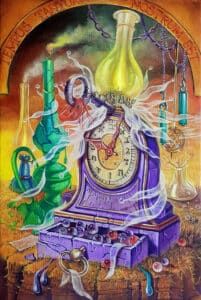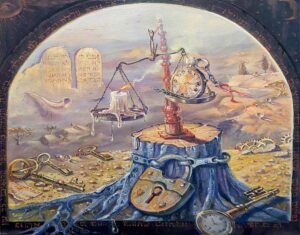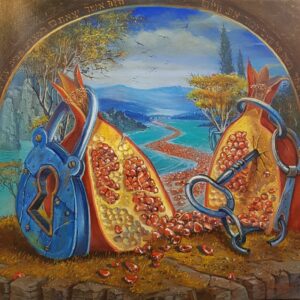
Imagine stepping through a canvas, not into a sun-drenched landscape or a bustling city street, but into a dreamscape where gravity bends, clocks melt, and violins sprout leaves. This is the realm of Surrealist Jewish paintings, a universe where the trauma and triumphs of Jewish history are reimagined in a prism of the subconscious, defying logic and embracing the fantastical.
Close your eyes. Feel the desert sands beneath your feet, the whispering wind carrying echoes of ancient prayers. Open them, and you’re not in the Negev, but in Chagall’s “The Wandering Jew”, where a violin-playing figure floats amidst a kaleidoscope of floating villages and upside-down cows. This poignant fusion of folktales and biblical imagery reflects the displacement and resilience of the Jewish people, their roots stretching across continents while their dreams remain stubbornly grounded in ancestral soil.
But Surrealism wasn’t just a refuge for the displaced; it was a weapon against oppression. Victor Brauner’s “The Minotaur”, with its bandaged head and watchful eye, evokes the horrors of the Holocaust, transforming the mythical beast into a symbol of monstrous human cruelty. The painting, with its unsettling mix of realism and distortion, forces the viewer to confront the unthinkable, refusing to let history fade into a sterile black and white.
Beyond the overt symbolism, Surrealism offered Jewish artists a space to explore the complexities of their identity. Max Ernst’s collages, with their fragmented figures and cryptic juxtapositions, mirror the fragmented nature of Jewish diaspora experiences. Torn between tradition and modernity, faith and skepticism, these works capture the internal struggles of a people constantly navigating a world that often felt hostile.
But amidst the shadows, there’s also a vibrant pulse of hope. Frida Kahlo’s “Moses”, with its radiant blue skin and outstretched arms, celebrates the resilience of the Jewish spirit. The painting, a fusion of Mexican and Jewish iconography, reminds us that even in the darkest times, the yearning for liberation and connection can blossom.
Surrealist Jewish paintings are not merely aesthetic marvels; they are portals into the collective soul of a people who have grappled with exile, persecution, and the constant reshaping of their identity. By venturing into these dreamlike landscapes, we gain a deeper understanding of the human experience, the enduring power of the imagination, and the unwavering spirit that continues to inspire and challenge us today.
Ready to delve deeper into this captivating world? Here are some resources to get you started:
- The Jewish Museum: https://thejewishmuseum.org/
- The Surrealism Movement website: https://www.theartstory.org/movement/surrealism/
- “Jewish Surrealism” by Sarah Lowndes: https://circafestival.org/event/l-bar-digitizing-the-past-made-present-by-queer-university/
Remember, art is a conversation, not a monologue. So, open your mind, engage with these enigmatic works, and let the dreamscapes of Surrealist Jewish paintings guide you on your own journey of discovery.





















